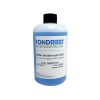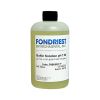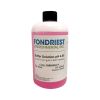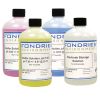Hach sensION+ 5052T Portable Combination pH Electrode
Features
- Low maintenance 3-in-1 design for the most challenging applications
- Protected against harsh field conditions
- Heavy-duty electrode handle design optimized for field calibration and storage
- Free ground shipping
- Expedited repair and warranty service
- Lifetime technical support
- More
Overview
The Hach sensION+ 5052T is a portable combination pH electrode with a glass body (protected by a plastic shroud), non-refillable gel reference electrolyte and built-in temperature sensor. It has a fixed 1 meter cable and MP5 connector dedicated for use with Hach sensION+ Portable pH meters. The 5052T has a large porous annular PTFE junction and is ideal for pH measurements in low ionic strength, high temperature, viscous, or other “difficult” sample types.
Consistency
The 5052T's non-refillable gel reference electrolyte and large annular junction with an integrated Pt1000 temperature sensor provides accurate, stable results without concerns for repeated maintenance in the most challenging of applications – including low ionic strength, high temperature, high particulate and viscous samples. A robust pH glass formulation with a protective polypropylene shroud, heavy-duty handle, and durable MP5 connector ensures protected, repeatable performance in the field.
Secure Interface
The electrode's calibration and storage tubes screw directly onto its portable heavy-duty handle. This design is ideal for field calibration and transport as it provides a secure interface between the electrode and calibration/storage tube, as well as reducing the risk of contamination in field conditions.
- Filling Solution: Non-refillable gel
- Material Sensor Body: Glass
- Temperature Range: Continuous use: 0 - 100 °C
- Thermistor: Pt1000
In The News
Ocean acidification: University of Washington's giant plastic bags help control research conditions
With oceans becoming more acidic worldwide, scientists are getting creative in designing experiments to study them. For example, one group at the University of Washington is using giant plastic bags to study ocean acidification. Each bag holds about 3,000 liters of seawater and sits in a cylinder-like cage for stability. The group at UW, made up of professors and students, is controlling carbon dioxide levels in the bags over a nearly three-week period, during which they are looking at the effects of increased acidity on organisms living near the San Juan Islands. “These mesocosms are a way to do a traditional experiment you might do in a lab or classroom,” said Jim Murray, professor of oceanography at the University of Washington.
Read MoreNOAA Alaska buoy network to monitor North Pacific ocean acidification
National Oceanic and Atmospheric Administration scientists detected signs of ocean acidification in the waters that hold the vulnerable and valuable fisheries of the North Pacific off the coast of Alaska, but they only had a snapshot of the action. “We know that in this place were important commercial and subsistence fisheries that could be at risk from ocean acidification,” said Jeremy Mathis, a NOAA Pacific Marine Environmental Laboratory researcher and professor at the University of Alaska Fairbanks. To understand how ocean acidification affects the North Pacific, NOAA scientists created a mooring network that collects constant in situ data on parameters contributing to acidification. They hope it will reveal seasonal trends and patterns left out by their snapshots.
Read MoreSpring 2025 Environmental Monitor Available Now
In the Spring 2025 edition of the Environmental Monitor, we highlight partnerships across the world and the importance of collaboration between government agencies, universities, environmental groups, local communities, and other stakeholders. From great white shark research in Cape Cod to monitoring fisheries in Lake Erie, this latest edition underscores partnerships that connect stakeholders in a watershed through environmental data. With an emphasis on data sharing, a combination of real-time and discrete sampling keeps the public and partners informed of environmental conditions. Our writers also sought out science professionals dedicated to working with peers within and outside of the environmental sector.
Read More














